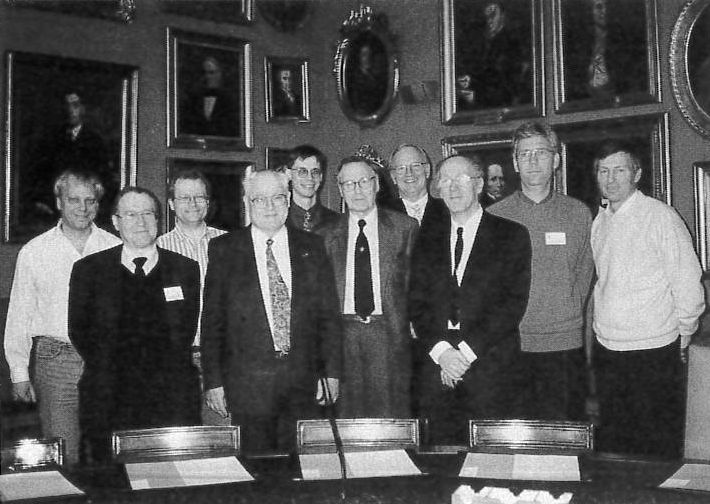


Awards and prizes
1998 Aminoff Prize to Janner, Janssen and de Wolff
 In the Session Hall of the Royal Swedish Academy of Sciences in Stockholm. Lecturers at the Aminoff Symposium, left to right: Vaclav Petricek, Michael Glazer, Sven Lidin , Aloysio Janner, Reine Wallenberg, Ivar Olovsson, Börje Johansson, Ted Janssen, Sander van Smaalen, Gervais Chapuis. (Photo courtesy of I. Olovsson)
In the Session Hall of the Royal Swedish Academy of Sciences in Stockholm. Lecturers at the Aminoff Symposium, left to right: Vaclav Petricek, Michael Glazer, Sven Lidin , Aloysio Janner, Reine Wallenberg, Ivar Olovsson, Börje Johansson, Ted Janssen, Sander van Smaalen, Gervais Chapuis. (Photo courtesy of I. Olovsson)
The Aminoff prize is awarded annually by the Royal Swedish Academy of Sciences to pioneering work in crystallography. Gregory Aminoff was the first in Sweden to apply X-ray crystallographic methods to determine the structure of some minerals in 1918.
The Aminoff prize for 1998 has been awarded to Aloysio Janner, Ted Janssen and Pieter Marten de Wolff "for their contributions to the theory and practice of modulated structure analysis".
A symposium on "Aperiodic crystals - periodic in higher-dimensional space" Mar. 27-28 at the Academy in Stockholm began with an introductory lecture "Twenty-five years of aperiodic crystals", in which Janssen noted that de Wolff and Janner happened to give their now historic lectures at the same session during the IUCr Congress in Kyoto 1973.
It was long considered that a real crystal is of necessity perfectly periodic in three dimensions. Early in the twentieth century there was evidence of crystals without lattice periodicity. However, these data were not taken seriously until the beginning of the seventies. Early examples were magnetic structures with a helicoidal spin arrangement and a period that is incommensurate with the periods of the underlying lattice. Soon many examples were found, including g-Na2CO3, NaNO2 and thiourea, where the aperiodicity was caused by an incommensurate modulation. Hundreds of materials have now been found which are as well ordered as conventional crystals but without lattice periodicity. An important part of the earth crust consists of aperiodic modulated minerals.
The real breakthrough to determine details of modulated structures came with the works by de Wolff, Janner and Janssen in the early seventies. They introduced analysis which has since become standard for modulated phases. By considering the diffraction pattern as n-dimensional, periodicity was reestablished. The achievements of the three prizewinners has had an enormous importance in practically all studies of modulated structures.
Janner gave a fascinating lecture on "The incommensurate way to the crystallography of snow" in which he analyzed the scaling properties of snow flakes(Acta Cryst. A53 (1997) 615-631).
Other lectures included "The art of coping with stress (G. Chapuis, Luasanne), "Incommensurate diffraction as an end member of disorder" (M. Glazer, Oxford), "Complex magnetic structures in simple crystal structures" (B. Johansson, Uppsala), "Combining electron and X-ray diffraction methods" (S. Lidin, Stockholm), "Incommensurate aspects of atoms, bonds and electrons in conducting crystals" (S. van Smaalen, Bayreuth), "The practical application of the superspace approach in crystal structure analysis" (V. Petricek, Prague) and "How to modulate structures - and why" (R. Wallenberg, Lund).
Unfortunately, Prof. de Wolff could not attend the award ceremony on Mar. 26 for health reasons. Later, when Janner and Janssen brought de Wolff his Aminoff medal, they talked about the beginning of the story of aperiodic crystals. Two weeks later de Wolff died. It is truly fortunate that his great achievements were honored before his death.
Ivar Olovsson
Chairman, National Committee of Crystallography


